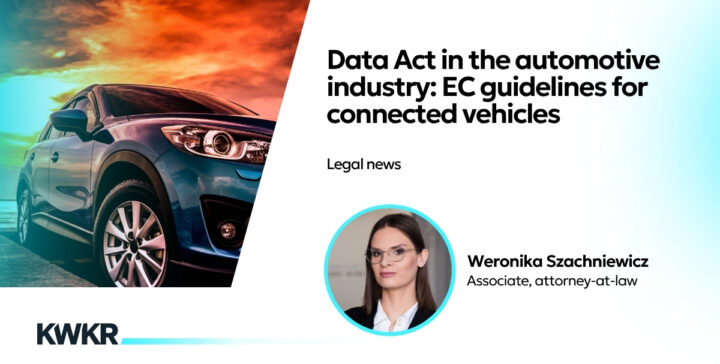European Commission guidelines on the Data Act – what they mean for the automotive sector
The European Commission has published Guidelines on the application of Regulation (EU) 2023/2854, known as the Data Act. While the document does not create new legal obligations, it clarifies how the rules on data sharing should be applied in practice—particularly with regard to connected vehicles. The Guidelines serve as a practical guide to the key obligations, though they do not cover the topic exhaustively.

From regulation to practice
The Data Act established general principles for fair access to and use of data. The new Commission Guidelines are intended to help companies interpret these provisions—especially in areas where the regulation’s language left room for doubt.
The Guidelines focus exclusively on Chapter II of the Data Act, which concerns relationships between businesses, users, and other companies accessing data generated by products. In practice, this means they primarily affect OEMs and service providers that rely on vehicle-generated data.
When is a vehicle “connected”?
In line with the recitals of the Regulation, the Guidelines confirm that to qualify as a connected product, it is sufficient that a vehicle enables electronic communication—not necessarily via the Internet. Therefore, most modern cars equipped with sensors, telematics systems, or Bluetooth or Wi-Fi connectivity meet this definition.
The Commission also emphasizes that the final assessment rests with the manufacturer or data holder, who must document how the product functions and determine whether it falls within the scope of the Data Act. The Guidelines are not legally binding—they are an interpretative tool designed to help avoid disputes with supervisory authorities.
“Vehicle-related services” – which services are covered?
The Guidelines clarify what should be understood as vehicle-related services. These are defined as services that:
- are directly related to a connected vehicle, and
- involve a two-way exchange of data between the vehicle and the service provider.
Beyond the definitions already provided in the Regulation, the Guidelines offer practical examples to illustrate their scope. Vehicle-related services include, for example:
- remote vehicle functions (e.g. unlocking doors via an app),
- intelligent predictive maintenance services,
- cloud services storing driver settings,
- dynamic route optimization systems.
Offline services—such as traditional repair and maintenance without data exchange—are excluded from this definition.
Which data must be shared?
The Guidelines specify which categories of data fall within the obligation to share, and which are excluded.
- Raw data
Data directly originating from vehicle sensors or user interactions—e.g. speed, tire pressure, camera images, brake status. Such unprocessed data must be made available.
- Pre-processed data
Data that has been filtered or calibrated but still reflects the vehicle’s actual condition (e.g. temperature, speed). If obtained without complex processing, these are also subject to the sharing obligation.
- Derived or inferred data
Data resulting from complex analysis or processing—such as predictive algorithms, driving behavior analytics, or aggregated data—are generally not required to be shared. However, simple calculations (e.g. average fuel consumption) are still considered shareable.
Examples of derived data include data from advanced driver assistance systems (ADAS), such as object detection, trajectory prediction, risk assessment, lane keeping, or adaptive cruise control.
- Predictions
Forecasts of future events (e.g. predicted failures) are excluded, unless a simpler equivalent (like a current sensor signal) can be shared instead.
Unavailable = not shareable
The Guidelines also clarify that data processed solely “on the edge” (i.e. within the vehicle) and immediately deleted cannot be shared, as it is not stored anywhere. Such data is considered unavailable and thus outside the scope of the obligation.
Because some of this information may be important for after-sales services, the Guidelines recommend that manufacturers consider, already at the vehicle design stage, which data could be relevant for independent repairers or fleet operators.
How data should be shared in practice
The Guidelines do not alter the Data Act’s core principles but provide clarity on practical implementation. Key takeaways for manufacturers and service providers include:
- “Easily accessible” data – The sharing process must be straightforward and not overly burdensome for the user.
- Data quality – Shared data must match the quality of the data used by the data holder. The Guidelines do not narrow the broad interpretative scope left by the Regulation.
- Format and method of sharing – These remain at the OEM’s discretion, provided they do not create access barriers. The data-sharing process should not require special tools or expert knowledge.
- Remuneration – Data must be provided free of charge to consumers. Between businesses, reasonable compensation may be charged, although neither the Data Act nor the Guidelines define what constitutes “reasonable.” The Commission indicates that further sector-specific guidance may follow.
Why the Guidelines matter for the automotive industry
Although not legally binding, the Guidelines represent the first official reference point for interpreting the Data Act.
They help vehicle manufacturers, telematics providers, and mobility service companies to better understand:
- which data they are actually required to share,
- what technical solutions should be implemented now, and
- how to minimize the risk of disputes over vehicle data access.
Further sector-specific guidance—on topics such as remuneration or data exchange formats—may be expected in the coming months.
Summary
The European Commission’s Guidelines on the Data Act do not amend the Regulation itself but give it a practical dimension, especially relevant to the automotive sector.
They signal that transparency, interoperability, and data-access-by-design are becoming the new standard in relationships between manufacturers, users, and service providers.
For automotive companies, this is a clear sign: it’s time to implement robust vehicle data governance policies—before data access becomes a matter of claims or regulatory scrutiny.

